Pope St. Symmachus (498-514)
Date of birth unknown; d. 19, July, 514. According to the "Liber pontificalis" (ed. Duchesne, I, 260) he was a native of Sardinia and his father was named Fortunatus. Symmachus was baptized at Rome (Thiel, "Epist. pont. rom.", I, 702), entered the ranks of the clergy of Rome, and was ordained deacon. Directly after the death of Pope Anastasius II, Symmachus was elected his successor by a majority of the Roman clergy at the Lateran Basilica on 22 November, 498. The election was approved by a part of the Roman senate and he was at once consecrated Bishop of Rome. Later on the same day a minority of the clergy who were friendly to the Byzantines and were supported by a party in the Senate met in the Basilica of Santa Maria Maggiore and elected the Roman archpresbyter Laurentius as antipope. According to Theodorus Lector (P.G., LXXXVI, 193), the Laurentian party was aided with money supplied chiefly by the rich Senator Festus, who hoped that Laurentius would be influenced by this to sign the "Henotikon", the edict of faith of the Emperor Zeno. The other authorities do not speak of such motives, which are very probable, and the testimony of Theodorus can very readily be accepted. Both parties, however, agreed that the two candidates should appear at Ravenna before the Gothic king Theodoric, the ruler of Italy, and abide by his decision. Theodoric pronouncing in favour of Symmachus on the ground that he was elected first and by the majority of the clergy, Laurentius submitted to the decision. At a synod held at Rome on 1 March, 499, the Acts of which have been preserved, Symmachus, who was now universally acknowledged, bestowed on Laurentius the Diocese of Nocera in Campania. The synod ordained that any Roman cleric who sought to gain votes for a successor to the papacy during the lifetime of the pope, or who called conferences and held consultations for that purpose, should be deposed. King Theodoric was given a vote of thanks by acclamation for his unpartizan decision. When the king came to Rome in the following year he had a brilliant reception both from the pope and the people. However, the Byzantine party, headed by the two senators Festus and Probinus, did not abandon its hostility and hope of overthrowing the pope and gaining the papal see for Laurentius. The opportunity occurred in the following year, 501. Pope Symmachus celebrated Easter on 25 March, following the old Roman cycle, while the Byzantines and others observed the feast on 22 April, according to a new reckoning. The Laurentian party appealed to King Theodoric against the pope, making other accusations besides this digression in the celebration of Easter. Theodoric summoned the pope and Symmachus set out to meet him. At Rimini Symmachus learned the contents of the indictment and, refusing to acknowledge the king as his judge, returned home. The opposing party now accused him of squandering the property of the Church and other matters. It gained in strength and occupied the Lateran palace, so that the pope was obliged to live near the Church of St. Peter outside the city walls. His opponents requested the king to call a synod for the investigation of the accusations and to appoint a visitor for Rome. Symmachus agreed to the calling of a synod, but he and his adherents protested against the sending of a visitor. Theodoric, however, sent as visitor Bishop Peter of Altinum in upper Italy, who was to administer the Roman Church in the place of the accused pope. Peter came to Rome and, contrary to the commands of king, allowed himself to be won over by the adherents of Laurentius, so that Theodoric at a later date dismissed him. Not long after Easter, between May and July, 502, the synod met in the basilica of Julius (Santa Maria in Trastevere). The pope declared before the synod that it had been called with his consent and that he was ready to answer the accusations before it, if the visitor were removed and he were re-established as the administrator of the Church. To this the majority of the bishops agreed and sent an embassy to the king to demand the execution of these conditions. Theodoric, however, refused, and demanded, first of all, an investigation of the accusations against the pope. A second session of the synod was held, therefore, on 1 September, 502, in the Sessorian basilica (Santa Croce in Gerusalemme), and the minority had the indictment made by the Laurentian party read aloud. Symmachus desired to go from St. Peter's to the synod in order to defend himself, but on the way there he was attacked by his opponents and maltreated, and, escaping only with great difficulty, returned to St. Peter's; several priests who were with him were killed or severely wounded. The Goths sent by Theodoric promised him a reliable escort but the pope now refused to appear before the synod, although invited three times. Consequently the assembled bishops declared at the third session, held about the middle of September, they could not pass judgment upon the pope, because he had appeared twice before his judges, and because there was no precedent showing that an occupant of the Roman See had been subjected to the judgment of other bishops. They called upon the opposing clergy to submit to the pope, and requested the king to permit the bishops to return to their dioceses. All these steps were in vain; the majority of the clergy and people sided indeed with Symmachus, but a minority of the clergy and a majority of the Senators were at that time partizans of Laurentius. A fourth session, therefore, was held on 23 October, 502, called the "Synodus Palmaris" (Palmary synod) either from the place where it was held (ad Palmata, Palma), or because it was the most important session (palmaris). At this session it was decided that on account of the reasons given earlier the decision must be left to the judgment of God; Symmachus was to be regarded as free from all the crimes of which he was accused, and therefore entitled to the full exercise of his episcopal office; the whole property of the church was to be transferred to him; whoever returned to his obedience should escape punishment, but whoever undertook ecclesiastical functions at Rome without papal permission was to be regarded as a schismatic. The decision was signed by seventy-five bishops, among them the bishops of Milan and Ravenna. Many bishops now returned to their dioceses. The majority, however, met with the Roman priests in St. Peter's for a fifth session under the presidency of Symmachus on 6 November, 502. The edict issued by the prefect Basilius, in 483, regulating the administration of the possessions of the Church was declared invalid and Symmachus issued a new edict respecting the administration of this property, and especially in regard to its sale.
King Theodoric, not satisfied with the decision of the synod, although the great majority of the Italian episcopate was on the side of the rightful pope, did nothing to carry out the new ordinances. Consequently the opposition called its candidate Laurentius again to Rome. He resided in the Lateran palace, which was in the hands of his adherents, while Symmachus retained the house of the bishop (episcopium) near St. Peter's. The division continued for four years, during which both parties carried on a furious quarrel at Rome. Laurentius had his portrait added to the series of popes in the Church of Saint Paul Without the Walls. However, certain prominent persons exerted their influence in favour of Symmachus, as Bishop Avitus of Vienne, who, at the request of the Gallican bishops, addressed an urgent letter to the Senate on behalf of the rightful pope and for the restoration of unity. Symmachus gradually won over a number of adherents of the opposition. The greatest factor in the healing of the schism was the interposition of Deacon Dioscurus of Alexandria, who had come to Rome. He was commissioned by Symmachus to go to Theodoric, and won the king over to the side of the rightful pope. Apparently political motives were involved, as the king wished to take action against the Laurentian party, which inclined to Constantinople. He commanded Senator Festus, the head of the hostile party, to return all Roman churches to Symmachus. Laurentius having lost many adherents among the senators the king's command was executed without difficulty. The antipope, obliged to leave Rome, retired to a farm belonging to his protector Festus. Only a small party still held to Laurentius and refused to recognize Symmachus as Bishop of Rome; but it was insignificant and was reconciled later to Hormisdas, the successor of Symmachus. During the schism a number of polemical writings appeared, as from the party of Laurentius the treatise "Contra Synodum absolutionis incongruae", to which Deacon Ennodius replied in "Libellus adversus eos qui contra Synodum scribere praseumpserunt" ("Mon. Germ. Hist.: Auct. ant.", VII, 48 sq.). While the author of the life of Symmachus in the completely preserved text of the "Liber pontificalis" is very favourable to the pope, the writer of another continuation of the papal biographies supports the cause of Laurentius ("Fragment Laurentine", ed. Duchesne in "Liber pontificalis", I, 44-46). During the dispute the adherents of Symmachus drew up four apocryphal writings called the "Symmachian Forgeries"; these were: "Gesta synodi Sinuessanae de Marcellino"; "Constitutum Silvestri", "Gesta Liberii"; "Gesta de purgatione Xysti et Polychronii accusatione". These four works are to be found in Coustant, "Epist. rom. pontif." (Paris, 1721), appendix, 29 sq.; cf. Duchesne, "Liber pontificalis", I, introduction, CXXXIII sq.: "Histoire littéraire des apocryphes symmachiens". The object of these forgeries was to produce alleged instances from earlier times to support the whole procedure of the adherents of Symmachus, and, in particular, the position that the Roman bishop could not be judged by any court composed of other bishops. Still these forgeries are not the first documents to maintain this latter tenet. ,p>Symmachus zealously defended the supporters of orthodoxy during the disorders of the Acacian schism. He defends, although without success, the opponents of the "Henotikon" in a letter to Emperor Anastasius I (491-518). At a later date many of the persecuted oriental bishops addressed themselves to the pope to whom they sent a confession of faith. Shortly after 506 the emperor sent him a letter full of invectives, to which the pope sent a firm answer, maintaining forcibly the rights and liberty of the Church (Thiel, "Epist. rom. pont.", I, 700 sq.). In a letter of 8 October, 512, addressed to the bishops of Illyria, the pope warned the clergy of that province not to hold communion with heretics. Soon after the beginning of his pontificate Symmachus interposed in the quarrel between the Archbishops of Arles and Vienne as to the boundaries of their respective territories. He annulled the edict issued by Anastasius II in favour of the Archbishop of Vienne and later (6 November, 513) confirmed the metropolitan rights of archbishop Caesarius of Arles, as these had been fixed by Leo I. Moreover, he granted Caesarius the privilege of wearing the pallium, the first-known instance of such a grant by the Holy See to a bishop outside of Italy. In a letter of 11 June, 514, he appointed Caesarius to represent the interests of the Church both in Gaul and Spain, to hold synods of the bishops in certain cases, to give letters of recommendation to clergy who journeyed to Rome. More important matters were to be laid before the Holy See. In the city of Rome, according to the "Liber pontificalis", the pope took severe measures against the Manichaeans, ordered the burning of their books, and expelled them from the city. He erected or restored and adorned various churches. Thus he built a Church of St. Andrew near St. Peter's, a Basilica of St. Agnes on the Via Aurelia, adorned the Church of St. Peter's, completely rebuilt the Basilica of Sts. Sylvester and Martinus, and made improvements over the Catacomb of the Jordani on the Via Salaria. He built episcopal houses (episcopia) to the right and left of the parvis of St. Peter's. These buildings were evidently connected with the residence of the pope for several years near St. Peter's during the disorders of the Laurentian schism. He also built asylums for the poor near the three churches of St. Peter, St. Paul, and St. Laurence that were outside the city walls. The pope contributed large sums for the support of the Catholic bishops of Africa who were persecuted by the rulers of the Arian Vandals. He also aided the inhabitants of the provinces of upper Italy who suffered so sorely from the invasion of the barbarians. After his death he was buried at St. Peter's. Symmachus is venerated in the Roman Church as a saint.
Susann Sowers Lusnia, "The Sessorian Complex: The 'Other' Severan Palace in Rome," presented at the 96th Annual Meeting, AIA/APA, 28 December 1994, Atlanta, Georgia.
Pope St. Sylvester I (314-335)
Date of birth unknown; d. 31 December, 335. According to the "Liber pontificalis" (ed. Duchesne, I, 170) he was the son of a Roman named Rufinus; the legendary "Vita beati Sylvestri" calls his mother Justa. After the death of Miltiades (Melchiades), Sylvester was made Bishop of Rome and occupied this position twenty-one years. This was the era of Constantine the Great, when the public position of the Church so greatly improved, a change which must certainly have been very noticeable at Rome; it is consequently to be regretted that there is so little authoritative information concerning Sylvester's pontificate. At an early date legend brings him into close relationship wtih the first Christian emperor, but in a way that is contrary to historical fact. These legends were introduced especially into the "Vita beati Sylvestri" (Duchesne, loc. cit., Introd., cix sq.) which appeared in the East and has been preserved in Greek, Syriac, and Latin in the "Constitutum Sylvestri"–an apocryphal account of an alleged Roman council which belongs to the Symmachian forgeries and appeared between 501 and 508, and also in the "Donatio Constantini". The accounts given in all these writings concerning the persecution of Sylvester, the healing and baptism of Constantine, the emperor's gift to the pope, the rights granted to the latter, and the council of 275 bishops at Rome, are entirely legendary. The pope, however, took part in the negotiations concerning Arianism and the Council of Nicæa, and the expression 'omooúsion was probably agreed upon with him before the council. The pontiff also sent legates to the first œcumenical council. Still it is not certain whether Constantine had arranged beforehand with Sylvester concerning the actual convening of the council, nor whether there was an express papal confirmation of the decrees beyond the signatures of the papal legates (cf. Funk in "Kirchengesch. Abhandlungen und Untersuchungen", I, 95, 501 sq.).
During Sylvester's pontificate were built the great churches founded at Rome by Constantine, e.g. the basilica and baptistery of the Lateran near the former imperial palace where the pope lived, the basilica of the Sessorian palace (Santa Croce), the Church of St. Peter in the Vatican, and several cemeterial churches over the graves of martyrs. No doubt the pope helped towards the construction of these churches. Sylvester's memory is especially connected with the tiitular Church of Equitius, which takes its name from a Roman presbyter who is said to have erected this church on his property. It was situated near the thermæ of Diocletian, and still exists. Parts of the present building may date from the fourth century. No doubt the pope contributed to the development of the liturgy of the Church at Rome. During his reign, moreover, the first martyrology of Roman martyrs was probably drawn up. Sylvester is connected also with the establishment of the Roman school of singing. on the Via Salaria he built a cemeterial church over the Catacomb of Priscilla, the ruins of which have lately been brought to light. In this church he was buried. His feast is given under 31 December in the "Depositio episcoporum", or list of the burial days of the Roman bishops, which was compiled barely a year after his death; the same date is given in the "Calendar" of Philocalus. This day, therefore, is doubtless the day of his burial. For his possible relations with Armenia, see Gregory The Illuminator.
The Catholic Encyclopedia
| |
The area, which in Antiquity was called ad Spem Veterem (because it was near the temple of Spes Vetus--Old Hope--that commemorated a battle fought against the inhabitants of Veii), was topographically part of the Caelian and, because of its marginal and peripheral position with respect to the Palatine city, from the 9th century BC onwards it was mostly given over to funerary uses. From the 5th century BC onwards, the area between porta Maggiore and S. Giovanni became an important road nexus, crossed by major roads, subsequently referred to as the Labicana, the Praenestina and the Caelimontana. In addition, since it was one of the highest points in the city, as many as eight aqueducts converged there, and among them the Claudian, which, built on high arches in opus quadratum made of tufa, are among the oldest monumental remains in the neighborhood (AD 52). Between 42 and 38 BC, as part of a general city planning scheme for the Esquiline, Maecenas transformed this area into a residential quarter, where large villae and domus of the wealthiest families of the time were established. At the end of the 2d century AD, part of the gardens (horti) ad Spem Veterem became the property of the family of the Varii, from which the name horti Variani is derived, and, immediately afterwards, became part of the imperial domains: the emperor Elagabalus (AD 218-22), of the family of the Severi, modified the suburban villa of the Varii, transforming it into a new imperial residence, structured around key monumental buildings (an amphitheatre, a circus, and nymphaea) laid out in a vast park. The Baths of Helen belong to the time of the emperor Alexander Severus (AD 222-235): they may not have been part of the imperial villa and are so named because in the 4th century AD they were restored by Helen, the mother of Constantine. The Aurelian Walls (AD 271-275) redefined the extension of the complex, incorporating into it only those structures that were useful for defensive purposes. Under Constantine (AD 306-337), however, the complex, significantly altered, continued to function still as an imperial residence under the name of Sessorian Palace. With the work done in that period, the layout of the 3d-century villa was enriched with public and private structures and, inside, a room was transformed into a palace chapel dedicated to the cult of the cross of Christ, according to the wishes of Empress Helena. In subsequent years, while the center of political and imperial life had been transferred to Constantinople, Rome traversed a period of profound crisis and inexorable decadence, that culminated in the sack of the city by Alaric in AD 410 and the plague of AD 590. The area of S. Croce followed a fate similar to that of the other parts of the city, becoming gradually abandoned and given over to farming. While the Palace and the public and private buildings fell slowly into ruin, the church continued to exist, becoming a place of pilgrimage as well as an important center of life, around which an active and flourishing religious community developed, which then passed to the Cistercians.
The amphitheatre was built by the emperor Elagabalus (AD 218-222) inside the Severan residence of Horti ad Spem Veterem with evident monumental intent, as is clearly shown by its dominant position and the construction technique. The word Castrense derives from castrum, which in late antiquity also acquired the meaning of imperial residence. In amphitheatres, gladiatorial games (munera) and animal hunts (venationes) were held, which were the preferred spectacles of the ancient Romans. The building, the exterior of which is laid out in three floors or orders, was elliptical in shape, with the arena in the center and the tiers for the spectators (cavea); four entrances provided access to the seats and to the balcony reserved for the emperors (pulvinar). Constructed entirely of brickwork, the amphitheatrum Castrense had 48 arches on the exterior, with pilasters and engaged Corinthian columns. The second order had pilasters surmounted by travertine corbels designed to hold up the tent (velarium) that protected the spectators from the sun during the spectacles. The building, which was directly linked to the palace by a corridor usable by vehicles, was reserved to the imperial court and could seat about 3,500 spectators. Recent excavations have brought to light the structures of the arena (approx. 68 x 51 m), paved in part with movable wooden slabs and communicating directly with the underground service areas beneath, that are even now perfectly preserved, designed to hold the stage scenery and the animals. The Aurelian Walls, built between AD 271 and 275, incorporated the amphitheatre in their circuit and turned its use into one of a defensive stronghold. According to a recent hypothesis, the Vivarium, the building where the animals were trained for the spectacles, located by the historian Procopius near the present Porta Maggiore, is to be identified with the amphitheatrum Castrense, already no longer in use by the end of the 3d century AD. It was probably here that, in the 6th century AD, Vitiges' Goths broke thru the wall, without being able, however, to enter the city. The monument was drastically resized during the pontificate of Paul IV (1556-1557), when, for defensive reasons, it was cropped by taking down the second and third floors. Subsequent destructions occurred in the 18th century due to the expansion of the convent of Cistercian monks, who notably reduced the remains of the amphitheatre, which with the Colosseum is the only one preserved in Rome.
These texts are from two panels on the garden gate at Santa Croce im Gerusalemme in Rome. The text was translated and made available online by Alan Zelenznikar(?) at www.alanzeleznikar.com/travels/rome_2001/soprintendenza.html
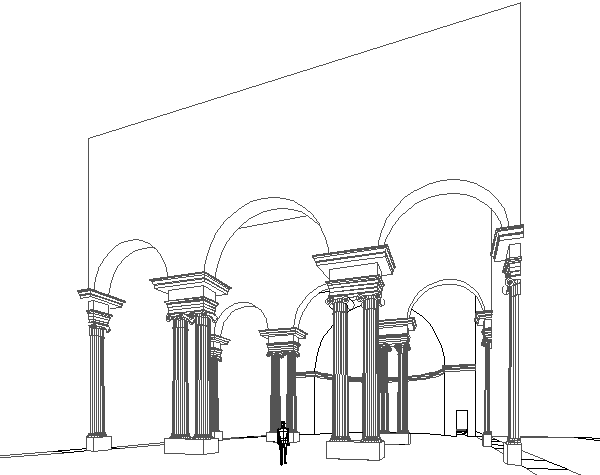
Interior perspective view of a reconstruction of the first Santa Croce in Gerusalemme (after Krautheimer).
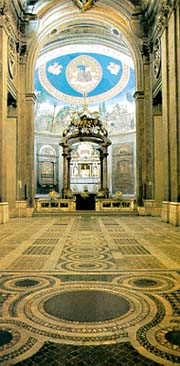
|
In 1743 by wish of the pope Benedetto XIV it was completed renewed by Gregorini and Passalacqua. It is one of the 7 churches which are jubilee destinations during the Holy Years. The façade dates back to the XVIII cent. by Gregorini, who inspired himself to the concave-convex style of Borromini. The interior is divided into three naves with apse and transept. The medieval cosmatesque style floor is very well preserved. Beside the pilasters there are eight granite columns from the ancient basilica. At the beginning of the main nave there are two holy water stoops dating back to the 1400's with fishes sculpted inside. The canopy dates back to the 1700's, in the apse there is a beautiful tomb of the 1400's by Sansovino. A staircase of the XV cent. leads to St. Helen's chapel decorated with a beautiful mosaic by Melozzo da Forlì. Beside the church there is a monastery run by Cistercenses monks built at the end of the X cent. Inside there is a wonderful library of the 1700's painted by Pannini, who is considered one of the most famous painters of his time. Behind the church rises the beautiful romanesque style campanile of the XII century.
|
CHURCH OF S. CROCE IN GERUSALEMME, erected by S. Helena. The interior has three aisles divided by pilasters, and with eight columns of Egyptian granite. The high altar is adorned by four columns of breccia-corallina, which support the canopy. Under the altar is an ancient urn, which contains the bodies of the holy martyrs Anastasio and Cesario. The frescos of the vault of the tribune are by Pinturicchio. The sunterranean chapel of S. Helena is decorated with paintings by Pomarancio, and with mosaics by. B. Peruzzi. Ladies are not allowed to enter this chapel, except on the saint's day. The church was erected in THE SESSORIUM PALACE, which was built by Varius, father of Elagabalus. This was afterwards turned into the Palace of helena, near which were her baths, remains of which exist in the adjoining vineyards; also of the reservoir; which remains are called by some the TEMPLE OF VENUS AND CUPID, from a statute found there. A Venus with Cupid at her feet, supposed to be the likeness of Salustia Barbia Orbiana, the wife of Alexander Severus, from an inscription on the pedestal saying that it was dedicated to Venus by one Salustia.
In the "Excerpta Valesiana de Odac" (lxix) it is mentioned as "the palace called Sessorium." In the buildings at the back of the church remains of a large palace can be traced. It is said by tradition that it took its name from a basilica which stood here where the cases of the slaves were tried. Another is, that here was the Praetorium or headquarters of the Praetorian perfect of the city. "It is said that Maximin, the perfect, had a small cord always suspended from a remote window of the Praetorium, the end of which had a llop which was easily drawn tight, by means of which he received secret information." (Marcellinus, xxviii, 7). The ruin to the left of the church has all the appearance of a basilica.
S. Russell Forbes, Rambles in Rome: An Archaeological and Historical Guide to the Museums, Galleries, Villas, Churches, and Antiquities of Rome and the Campagna (London: Thomas Nelson and Sons, 1882), p. 221.
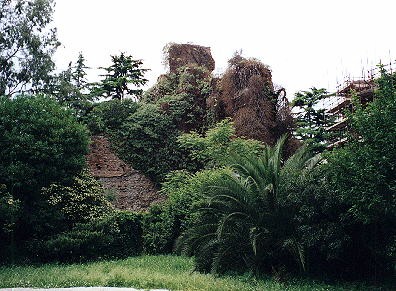
Ruins of the Temple of Venus and Cupid.
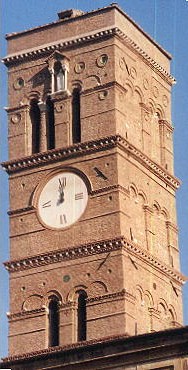
|
Santa Croce in Gerusalemme
Santa Croce, one of the "Seven Churches" of Rome, owes its origin to the Empress helena, mother of Constantine, who in her zeal for Christianity made a pilgrimage to Jerusalem and brought back a collection of relics, including a portion of the Saviour's cross, for the purpose of forming a pilgrims' shrine for those who could not afford time and money for the journey to the Holy Land. The church she founded, was probably a hall of the Sessorian palace in which she resided; it was called Basilica Heleniana, or Sessoriana.
The primitive church was rebuilt by Pope Lucius II, in 1114, and modernized in 1743 by Gregorini, who added the baroque facade. The campanile dates from 1196.
The sacred relics preserved in the church include a part of the Cross and of its inscription, one of the nails, thorns from the crown, and the finger with which St. Thomas convinced himself of the reality of the wound in the side of Christ.
The tribune is covered with frescos reprsenting the discovery of the Cross. The oldest part of the church is the chapel of St. Helena in the crypt (Ladies are not permitted except on the festival of the saint, March 20th), the florr of which was built upon a soil composed of earth brought from Jerusalem.
J. & M.L. Fattorusso, Rome Eternally Beautiful (Florence: Giuseppe Fattorusso,1937), p. 598.
The notion of women not being allowed to enter the Helena Chapel (which is accessed via the door to the right of the apse) except on 20 March, the date of the chapel's dedication, comes from an inscription on the wall of the stairwell leading from the basilica to the chapel. This "rule" is today no longer regarded.
Given the nature of the relics within the chapel, which all relate to Christ's crucifixion, the original rule of the chapel may actually have been that only women and not men were allowed in the chapel on 20 March. This reasoning coincides with the Scriptural account of St. John which relates how, with the possible exception of St. John himself, only Mary the mother of Jesus, Mary the aunt of Jesus, and Mary Magdalene remained with Christ until His death.
|
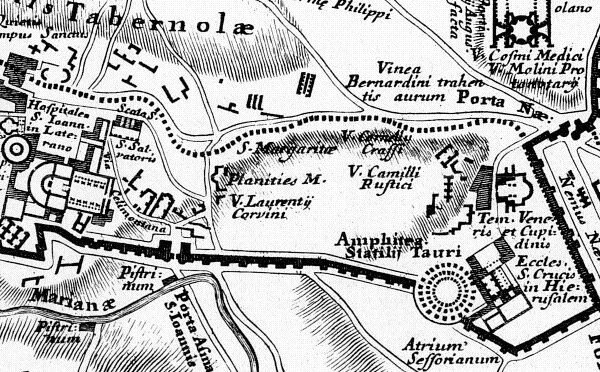
Detail of the Leonardo Bufalini map of Rome (1551), specifically the area of St. John Lateran and Santa Croce in Gerusalemme. This map is a version of the Bufalini map as redrawn by Nolli in the mid-eighteenth century.
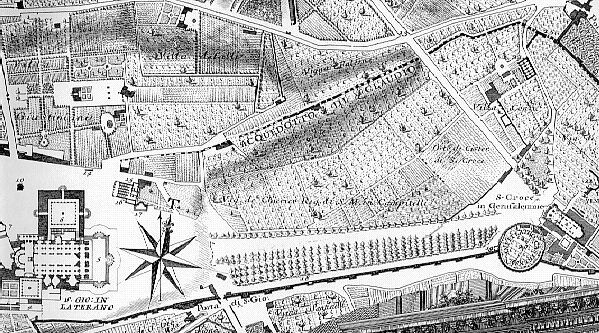
Detail of the Nolli map of Rome (1748), specifically the area of St. John Lateran and Santa Croce in Gerusalemme.
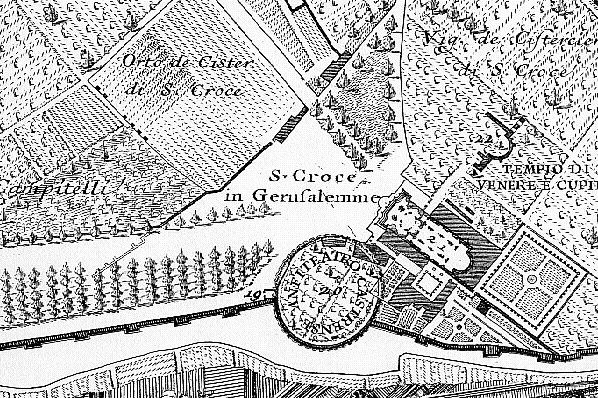
Detail of the Nolli map of Rome (1748), specifically the area of Santa Croce in Gerusalemme.
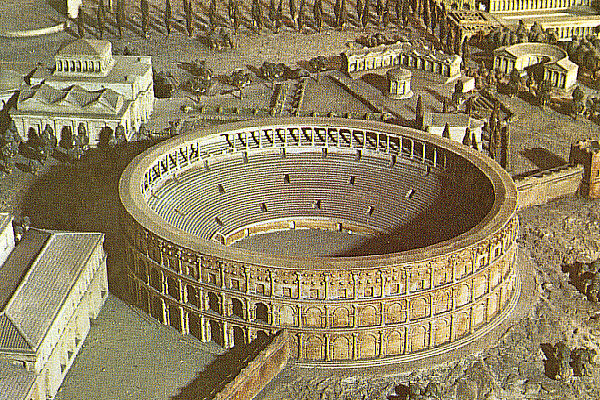
View of the model of ancient Rome, which is at the xxxx museum. This image here is a scan from Leonadro B. Dal Maso, Rome of the Caesars (Florence: Bonechi-Edizioni, 1974), p. 80.
Festivals of the Holy Cross
The Invention of the Holy Cross.--This is now kept by the Western Church upon 3 May, but so far as our somewhat uncertain data allow us to judge, the real date of St.Helena's discovery was 14 September, 326. Upon this same day, 14 September, took place the dedication of Constantine's two churches, that of the Anastasis and that of Golgotha Ad Crucem, both upon Calvary, within the precincts of the present church of the Holy Sepulchre. The portion of the Holy Cross preserved in Jerusalem afterwards fell into the hands of the Persians, but was recovered by the Emperor Heraclius, and, if we may trust our authorities, was solemnly brought back to Jerusalem on 3 May, 629. This day, strangely enough, seems to have attracted special attention among Celtic liturgists in the West and, though disregarded in the East, has passed through Celtic channels (we meet it first in the Lectionary of Silos and in the Bobbio Missal) into general recognition under the mistaken title of "Invention of the Cross". Curiously enough the Greek Church keeps a feast of the apparition of the Cross to St. Cyril of Jerusalem on 7 May, though that of 3 May is unknown in the East.
The Catholic Encyclopedia under "The Cross and Crucifix in Liturgy".
Archaeology of the Cross and Crucifix
The second event was of even greater importance. In the year 326 the mother of Constantine, Helena, then about 80 years old, having journeyed to Jerusalem, undertook to rid the Holy Sepulchre of the mound of earth heaped upon and around it, and to destroy the pagan buildings that profaned its site, Some revelations which she had received gave her confidence that she would discover the Saviour's Tomb and His Cross. The work was carried on diligently, with the co-operation of St. Macarius, bishop of the city. The Jews had hidden the Cross in a ditch or well, and covered it over with stones, so that the faithful might not come and venerate it. Only a chosen few among the Jews knew the exact spot where it had been hidden, and one of them, named Judas, touched by Divine inspiration, pointed it out to the excavators, for which act he was highly praised by St. Helena. Judas afterwards became a Christian saint, and is honoured under the name of Cyriacus. During the excavation three crosses were found, but because the titulus was detached from the Cross of Christ, there was no means of identifying it. Following an inspiration from on high, Macarius caused the three crosses to be carried, one after the other, to the bedside of a worthy woman who was at the point of death. The touch of the other two was of no avail; but on touching that upon which Christ had died the woman got suddenly well again. From a letter of St. Paulinus to Severus inserted in the Breviary of Paris it would appear that St. Helena. herself had sought by means of a miracle to discover which was the True Cross and that she caused a man already dead and buried to be carried to the spot, whereupon, by contact with the third cross, he came to life. From yet another tradition, related by St.Ambrose, it would seem that the titulus, or inscription, had remained fastened to the Cross.
After the happy discovery, St. Helena and Constantine erected a magnificent basilica over the Holy Sepulchre, and that is the reason why the church bore the name of St. Constantinus. The precise spot of the finding was covered by the atrium of the basilica, and there the Cross was set up in an oratory, as appears in the restoration executed by de Vogüé. When this noble basilica had been destroyed by the infidels, Arculfus, in the seventh century, enumerated four buildings upon the Holy Places around Golgotha, and one of them was the "Church of the Invention" or "of the Finding". This church was attributed by him and by topographers of later times to Constantine. The Frankish monks of Mount Olivet, writing to Leo III, style it St. Constantinus. Perhaps the oratory built by Constantine suffered less at the hands of the Persians than the other buildings, and so could still retain the name and style of Martyrium Constantinianum. (See De Rossi, Bull. d' arch. crist., 1865, 88.)
A portion of the True Cross remained at Jerusalem enclosed in a silver reliquary; the remainder, with the nails, must have been sent to Constantine, and it must have been this second portion that he caused to be enclosed in the statue of himself which was set on a porphyry column in the Forum at Constantinople; Socrates, the historian, relates that this statue was to make the city impregnable. One of the nails was fastened to the emperor's helmet, and one to his horse's bridle, bringing to pass, according to many of the Fathers, what had been written by Zacharias the Prophet: "In that day that which is upon the bridle of the horse shall be holy to the Lord" (Zach., xiv, 20). Another of the nails was used later in the Iron Crown of Lombardy preserved in the treasury of the cathedral of Monza. Eusebius in his life of Constantine, describing the work of excavating and building on the site of the Holy Sepulchre, does not speak of the True Cross. In the story of a journey to Jerusalem made in 333 (Itinerarium Burdigalense) the various tombs and the basilica of Constantine are referred to, but no mention is made of the True Cross. The earliest reference to it is in the "Catecheses" of St. Cyril of Jerusalem (P. G., XXXIII, 468, 686, 776) written in the year 348, or at least twenty years after the supposed discovery.
In this tradition of the "Invention", or discovery of the True Cross, not a word is said as to the smaller portions of it scattered up and down the world. The story, as it has reached us, has been admitted, since the beginning of the fifth century, by all ecclesiastical writers, with, however, many more or less important variations. By many critics the tradition of the finding of the Cross through the work of St. Helena. in the vicinity of Calvary has been held to be mere legend without any historical reality these critics relying chiefly upon the silence of Eusebius, who tells of all else that St. Helena did in Jerusalem, but says nothing about her finding the Cross. Still, however difficult it may be to explain this silence, it would be unsound to annihilate with a negative argument a universal tradition dating from the fifth century. The wonders related in the Syriac book "Doctrina. Addai" (sixth century) and in the legend of the Jew Cyriacus, who is said to have been inspired to reveal to St. Helena, the place where the Cross was buried, are responsible at least in part for the common beliefs of the faithful on this matter. These beliefs are universally held to be apocryphal. (See Duchesne, Lib. Pont., I, p. cviii.) However that may be, the testimony of Cyril, Bishop of Jerusalem from 350 or 351, who was on the spot a very few years after the event took place, and was a contemporary of Eusebius of Cæsarea, is explicit and formal as to the finding of the Cross at Jerusalem during the reign of Constantine this testimony is contained in a letter to the Emperor Constantius (P. G. XXXIII, 52, 1167; and cf. 686, 687). It is true that the authenticity of this letter is questioned, but without solid grounds. St. Ambrose (De obit. Theod., 45-48 in P.L., XVI, 401) and Rufinus (Hist. eccl., I, viii in P. L., XXI, 476) bear witness to the fact of the finding. Silvia of Aquitaine (Peregrinatio ad loca sancta, ed. Gamurrini, Rome 1888. p. 76) assures us that in her time the feast of the Finding was commemorated on Calvary, that event having naturally become the occasion of a special feast under the name of "The Invention of the Holy Cross". The feast dates from very early times at Jerusalem, and it was gradually introduced into other Churches. Papebroch (Acta SS., 3 May) tells us that it did not become general until about the year 720. In the Latin Church it is kept on the 3rd of May; the Greek Church keeps it on the 14th of September the same day as the Exaltation, another feast of very remote origin, supposed to have been instituted at Jerusalem to commemorate the dedication of the basilica of the Holy Sepulchre (335) and thence introduced at Rome.
Constantine's vision of the Cross, and perhaps another apparition which took place in Jerusalem in 346, would seem to have been commemorated in this same feast. But its chief glory is its connection with the restoration of the True Cross to the Church of Jerusalem, after it had been carried away by the Persian king, Chosroes (Khusrau) II, the conqueror of Phocas, when he captured and sacked the Holy City. This Chosroes was afterwards vanquished by the Emperor Heraclius II and in 628 was assassinated by his own son Siroes (Shirva), who restored the Cross to Heraclius. It was then carried in triumph to Constantinople and thence, in the Spring of the year 629, to Jerusalem. Heraclius, who wished to carry the Holy Cross upon his own shoulders on this occasion, found it extremely heavy, but when, upon the advice of the Patriarch Zacharias, he laid aside his crown and imperial robe of state, the sacred burden became light, and he was able to carry it to the church. In the following year Heraclius was conquered by the Mahommedans, and in 647 Jerusalem was taken by them.
In reference to this feast the Paris Breviary associates with the memory of Heraclius that of St. Louis of France, who, on 14 September, 1241 barefoot and divested of his royal robes, carried the fragment of the Holy Cross sent to him by the Templars, who had received it as a pledge from Baldwin. This fragment escaped destruction during the Revolution and is still preserved at Paris. There, also, is preserved the incombustible cross left to the abbey of Saint-Germain-des-Prés by the Princess Anna Gonzaga, together with two portions of the Nails. Very soon after the discovery of the True Cross its wood was cut up into small relics and quickly scattered throughout the Christian World. We know this from the writings of St. Ambrose, of St. Paulinus of Nola, of Sulpicius Severus, of Rufinus, and, among the Greeks, of Socrates, Sozomen, and Theodoret (cf. Duchesne, "Lib, Pont.", I, p. cvii; Marucchi "Basiliques de Rome", 1902, 348 sq.; Pennacchi, "De Inventâ Ierosolymis Constantino magno Imp. Cruce D. N. I. C.", Rome, 1892; Baronius, "Annales Eccl,", ad an. 336, Lucca, 1739, IV, 178). Many portions of it are preserved in Santa Croce in Gerusalemme at Rome, and in Notre-Dame at Paris (cf. Rohault de Fleury, "Mémoire", 45-163; Gosselin, Notice historique sur la Sainte Couronne et les autres Instruments de la Passion de Note-Dame de Paris", Paris, 1828; Sauvage, "Documents sur les reliques de la, Vrai Croix", Rouen, 1893). St. Paulinus in one of his letters refers to the redintegration of the Cross, i.e. that it never grew smaller in size, no matter how many pieces were detached from it. And the same St. Paulinus received from Jerusalem a relic of the Cross enclosed in a golden tube, but so small that it was almost an atom, "in segmento pene atomo hastulæ brevis munimentum præsentis et pignus æternæ salutis" (Epist. xxxi ad Severum).
from The Catholic Encyclopedia under "Archaeology of the Cross and Crucifix".
aerial photo views of Santa Croce
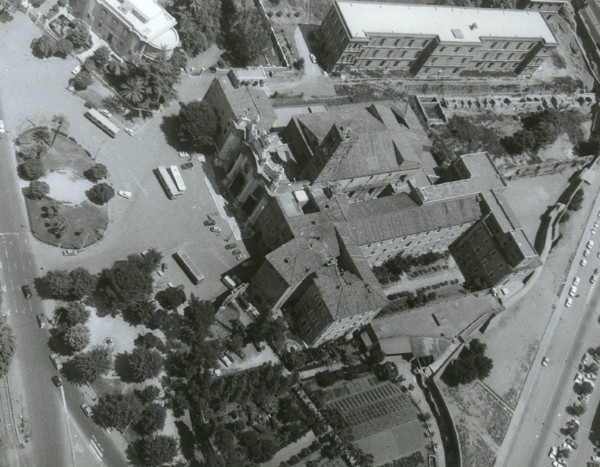
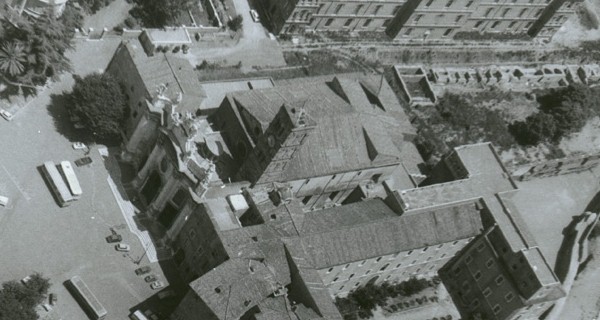
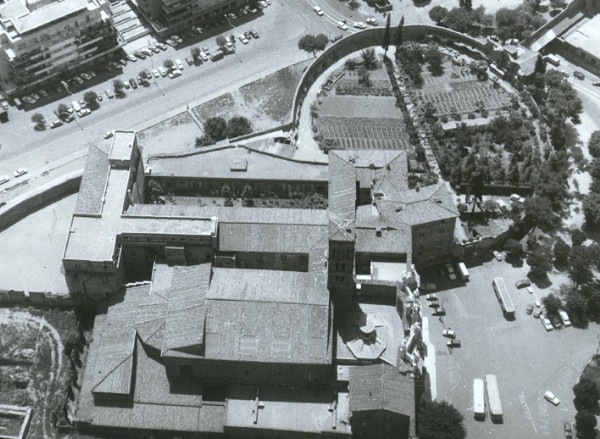
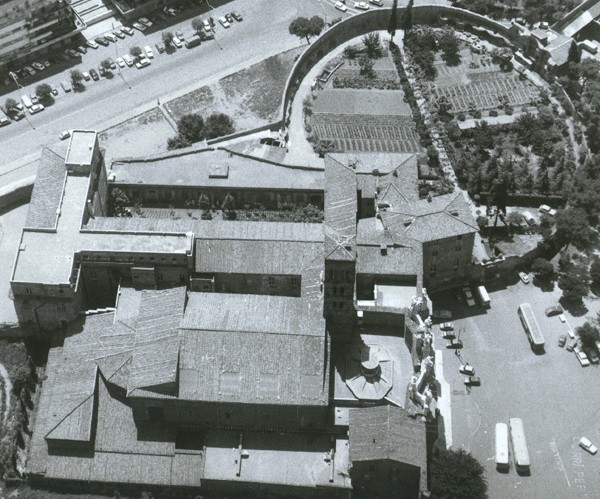
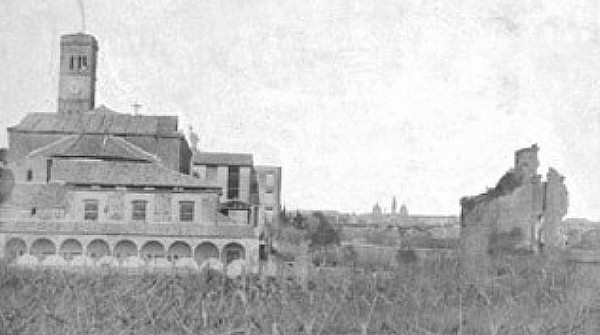
View of the back of Santa Croce and Sessorian remains.
|












